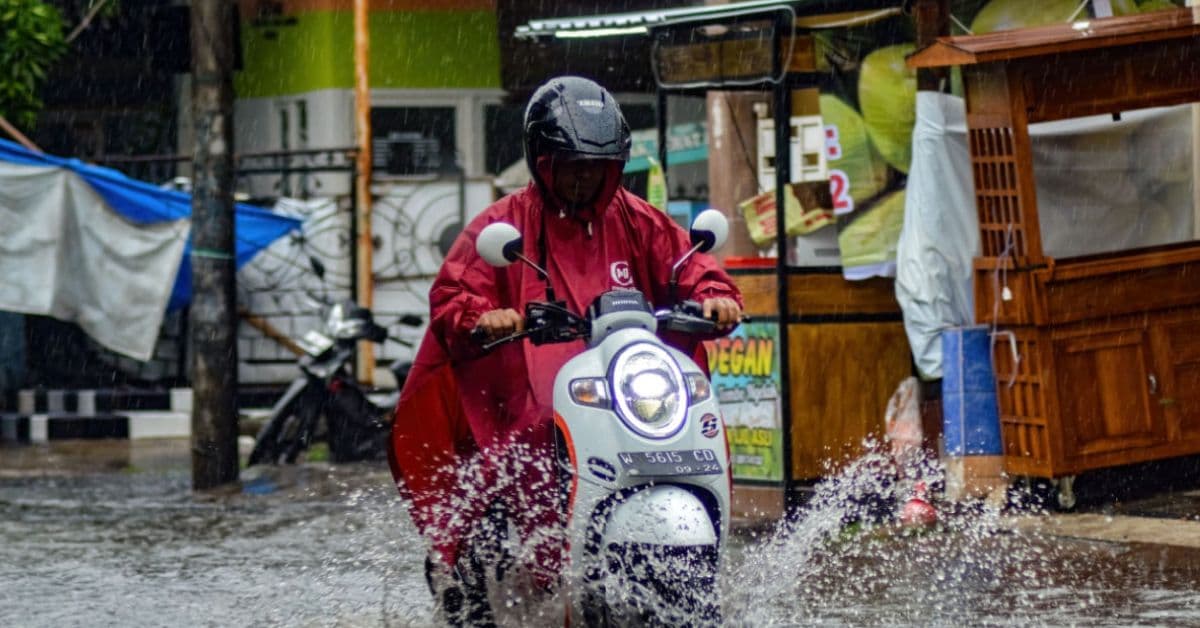scroll for more! ⟶
Cinchy Blog / Essential Tips for Safe Scooter Riding During Bali’s Rainy Season
Preventive Tips for Driving Safely During Road Floating in Bali’s Rainy Season
Published: 20 Jul 2025
By Ulfah Alifah
Travel Enthusiast

Book Your Ride in Just 1 Minute!
Free Cancellation
24/7 Support
Insurance
Start Date - End Date
Start Time
-- : -- --
End Time
-- : -- --
Duration
0 Day(s)
Bali’s rainy season transforms the island with lush greenery and cooler air. But for anyone driving a scooter or motorbike, rain also brings unique challenges—especially the risk of “floating” roads. Roads that appear to float happen when heavy rain causes water to accumulate faster than it drains, forming wide puddles and slippery surfaces. For Bali’s many two-wheel commuters and travelers, understanding how to ride safely during wet weather is vital.
This article gives practical tips and preventive steps to keep you safe while scootering during Bali’s rainy season.
Why Road Floating Happens in Bali
Bali’s tropical climate means the rainy season often includes sudden, heavy showers. Streets may not drain fast enough, creating puddles or flash floods, especially in low-lying areas. Road “floating” refers to situations when the road surface is fully or partially submerged. This makes it tough to see hazards like potholes or uneven pavement, and increases the risk of skidding.
Essential Scooter Prep Before the Rain
Before you hit the road:
Check Tire Condition: Good tire tread helps grip wet roads and prevents slipping. Replace worn tires.
Check Brakes: Make sure your brakes are responsive. Wet or worn brake pads reduce stopping power.
Lights and Signals: Ensure your headlights, brake lights, and turn signals are bright and visible.
Rain Gear: Carry a waterproof jacket, pants, and shoes or boots—wet clothes can lower your focus and comfort.
Helmet with Visor: A clean visor keeps rain out of your eyes and improves visibility.
Read Also:
18 Essential Apps to Download in Bali for Foreigners
Best Practices for Scootering in the Rain
1. Slow Down
Water on the road reduces traction. Ride slower than usual to give yourself more time to react to hazards. Approaching intersections, turns, and slopes at reduced speeds lowers the risk of losing control.
2. Increase Following Distance
Leave at least twice the normal distance between you and the vehicle ahead. Stopping distances increase dramatically on wet surfaces.
3. Use Both Brakes Smoothly
Don’t brake suddenly. Instead, apply both front and rear brakes gently and gradually. Sudden braking on wet roads can cause wheels to lock and the bike to skid.
4. Avoid Sudden Moves
Avoid jerking the handlebar, quick acceleration, or abrupt turns. Gentle, smooth actions help maintain balance and control.
5. Watch the Road Surface
Steer clear of painted lines, metal grates, and mud. These become extra slippery when wet.
Puddles may hide potholes or debris—ride around them when you can.
If you must cross a puddle, approach slowly and perpendicularly. Keep the throttle steady to prevent water from entering the exhaust.
6. Use the Phone Holder for Navigation
Install your phone in the provided holder to keep both hands on the handlebars. Only check maps when stopped somewhere safe.
Be Ready for Sudden Weather Changes
Rain showers in Bali can start and stop quickly. Before each ride, check the weather forecast.
Plan Your Route: Favor main roads and avoid flood-prone areas if expected rain is heavy.
Look for Shelter Markers: Identify gas stations or shops along your route where you can stop if rain turns severe.
Set Pick-Up and Drop-Off Wisely: Arrange delivery or return of your scooter at a dry, paved area.
Extra Safety Equipment Tips
Keep Hair Nets Dry: Wet hair nets can cause your helmet to slip. Store them in a waterproof bag.
USB Port Use: Carry a power bank if you need your phone for longer trips. Avoid plugging in while riding in heavy rain.
Check Insurance Coverage: Make sure you know what your scooter insurance covers, especially for wet-weather accidents.
What To Do During Extreme Conditions
If the rain becomes too heavy, or roads are deeply flooded, pull over and wait under shelter.
Never attempt to drive through water you cannot see the bottom of—deep water may stall your scooter or sweep it away.
After the rain, check your scooter for signs of water in the engine or exhaust before continuing.
Post-Ride Care
After riding in the rain:
Wipe down your scooter and helmet to remove water and mud.
Dry your shoes, jacket, and gloves before your next trip.
Inspect the scooter’s brakes and chain for excess moisture or dirt.
Conclusion
Riding a scooter during Bali’s rainy season requires more focus and preparation, but it’s totally doable with the right steps. Start by checking your scooter, planning ahead for weather, and riding cautiously. Respect the risks of roads “floating” and never rush.
With these preventive tips, you can explore Bali safely and comfortably, rain or shine. Ride safe, enjoy the beauty of Bali, and remember—your awareness is your best protection!

